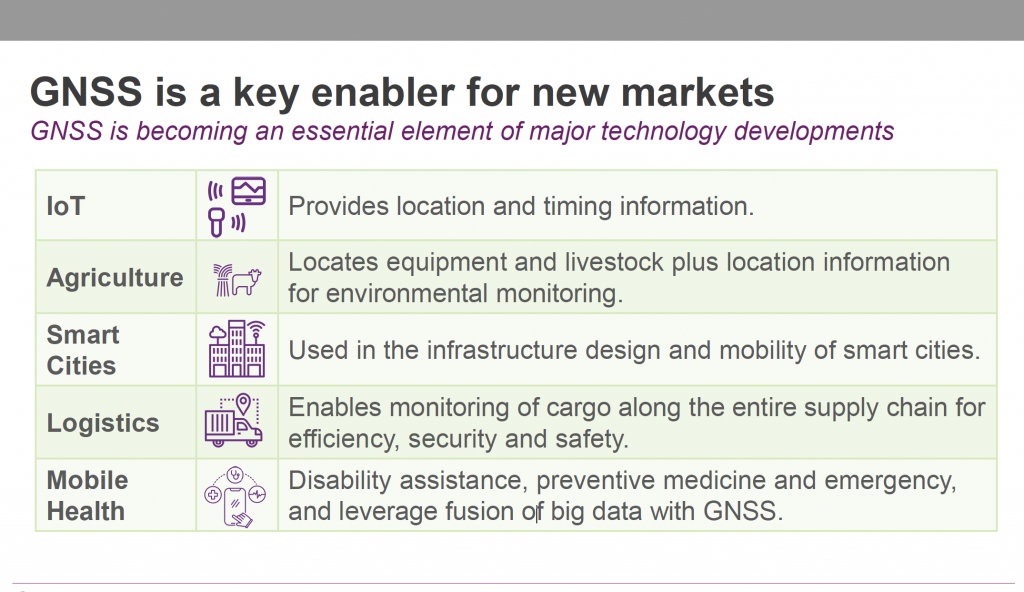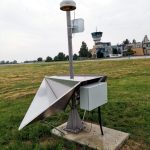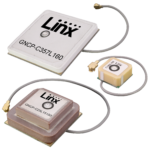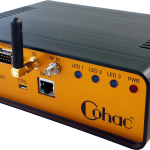Imagination Technologies today announced the offering of the Ensigma Location GNSS IP core that supports GPS, GLONASS, Galileo, and BeiDou as well as several Satellite-Based Augmentation Systems (SBAS) including WAAS and EGNOS. Designed for ultra-low power consumption, the IP is designed to optimize battery powered remote IoT sensors and edge devices, wearables, health monitors, consumer mobile products, automotive after-sales products such as insurance boxes and road tolling equipment, and asset tracking devices.
Ahead of today’s announcement, Richard Edgar, Director of Communications Technology, for Ensigma, told Inside GNSS last week about the company’s planned offering.
“We believe that the market is changing and that GNSS technology is more than just for satnav. Everybody uses satnav in their car to find where they are. But we believe that there are a lot of new technologies, and applications and new markets,” Edgar said. “GNSS is a way to provide timing and to locate equipment and livestock, and it’s also used in infrastructure for smart cities.
“One of the key things in these markets is power consumption. I always ask people, how often do you want to change the battery? And most people answer ‘Never’. Traditional GNSS receivers tend to require relatively high power consumption…so to add GNSS into these types of equipment is a major challenge. We believe it requires a different approach.”

Evolving use models mean that a growing number of battery operated products must support positioning, navigation, and timing (PNT) services. Consumers want to track their devices, but don’t want to re-charge batteries frequently. In industrial and agricultural environments, users need to track mobile assets to improve efficiency and reduce operational costs, but it isn’t possible to frequently change batteries across numerous devices in disparate locations. In addition, new regulatory requirements mandate the use of location services in some products, for example to address spectrum sharing requirements in IoT devices and base stations.
With Ensigma GNSS IP, companies can integrate PNT services while keeping power consumption to a minimum, and can also help to reduce the overall system cost through a reduced bill of materials (BOM).
Martin Woodhead, EVP, Ensigma Communications, Imagination, said in today’s news release: “Our customers are increasingly combining connectivity such as Wi-Fi, Bluetooth, and 802.15.4 with GNSS technology in one chip. Ensigma GNSS IP provides a power-efficient solution that they can integrate into their own silicon to save on the total solution cost. And because the Ensigma portfolio includes support for 30 other connectivity standards, we’re also simplifying their IP procurement process. With Ensigma GNSS IP, customers can ultimately save on power, cost, and resources.”
Malik Saadi, managing director and vice president, strategic technologies, ABI Research, says: “Silicon and system vendors designing their own silicon need low-power, high-quality GNSS IP. Until now, they’ve had to either settle for a restricted set of features, or use a companion chip to provide comprehensive functionality. ABI Research has consistently maintained the integration of fully featured GNSS with other wireless technologies has the ability to enhance the overall performance of the chip and lower the overall power consumption without compromising cost.”
Key features of the Ensigma GNSS IP include:
- Ultra-low power operation
- Ability to share location information with external wireless technologies such as LTE or Wi-Fi
- Options to share peripherals such as memory and system clock to enable reduced total system cost
- High sensitivity for indoor location
- Support for assistance information using external sources such as LTE and Wi-Fi to improve time to first fix
- Radio Frequency Interference (RFI) detection and mitigation
With Ensigma GNSS IP, customers can choose a configuration, from standalone to highly integrated, that works best for their specific system implementation. The IP can be configured for lowest power or highest integration, and is designed to fit into any existing solution with the optimum level of design and resource re-use.
Solving the GNSS Power Challenge
The Ensigma GNSS IP builds on the proven Ensigma connectivity engine which incorporates an ultra-low power CPU core. Imagination employed many innovative GNSS techniques to build on the efficiency of this platform to ensure low-power consumption. The GNSS IP includes dedicated hardware blocks which enable much lower power compared to a software only solution. In addition, the GNSS IP not only supports continuous fix techniques, but it also supports power-efficient “capture and process” for devices that only require periodic location updates. This feature further conserves battery life by capturing data, such as fitness information from a wearable device, and storing it for later processing.
Edgar said many applications only need a “snapshot” on location and this can conserve battery life.
“Many markets do not require ‘always-on’ location,” he explained. “For example I’ve never found the need to track sheep or cows in real time, but knowing where they are once a day or knowing if they move outside the field could be important. So, we actually believe that taking a snapshot once a day is actually the right way to go.”
Ensigma GNSS IP is designed to be used with a wide range of GNSS receivers; the initial solution is optimized for use with SaberTek’s ultra-low power GNSS receiver.
“SaberTek’s ultra-low-power RF IP for GNSS integrates seamlessly with Imagination’s Ensigma GNSS IP. Combined, these IPs offer the complete GNSS solution with best performance at lowest power consumption in the market,” said Farbod Behbahani, president and CEO, SaberTek. “SaberTek’s wide range of low-power, low-cost RF transceiver IPs for wireless IoT are a great match for the low-power Ensigma wireless IP cores. With the increasing demand for GNSS across markets, the combination our technologies can enable companies to cost-effectively build ultra-low power location capability into their products.”
The broad portfolio of Ensigma wireless communications IP comprises solutions for 30 wireless standards in Wi-Fi, Bluetooth, 802.15.4, audio and TV broadcast. Ensigma uniquely provides an end-to-end solution encompassing all parts of the wireless system – RF, baseband, software and interoperability and RF compliance. Ensigma connectivity and broadcast IP can be supplied as a single standard or as highly complex multi-standard solutions such as Wi-Fi and Bluetooth combos; scalable from low-power, low data-rates to high performance, high data rate solutions.






